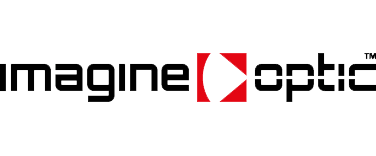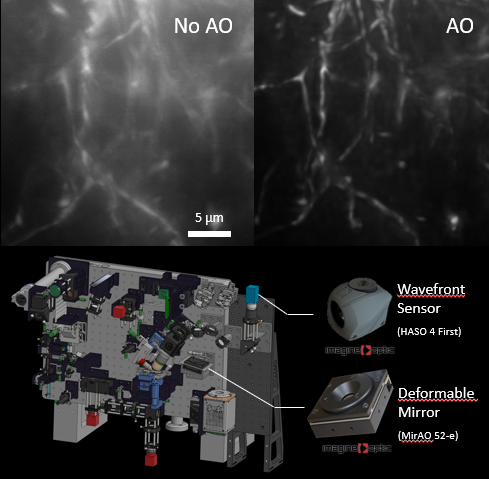Light-Sheet Fluorescence Microscopy, a successful bio-imaging method.
As a remarkable answer to the growing interest in rapid 3D visualization of biological samples in vivo, Light-sheet Fluorescence Microscopy (LSFM) has become a valuable tool for biologists. Indeed, it enables optical sectioning of a sample with low photo-toxicity and low photo-bleaching at a very fast imaging rate. Many implementations of LSFM now exist, with a great number of commercial and home-made solutions. Among all those instruments, Lattice Light-Sheet Microscopy (LLSM) stands out as one of the most efficient techniques for fast 3D imaging at sub-cellular scale. However, sample-induced aberrations are still limiting for in-depth observations inside thick tissues.
Active Image Optimization (AIO) enables deeper and better resolved LLSM
To get rid of these aberrations, Adaptive Optics (AO) was integrated in some LLSM setups, providing signal and resolution enhancement, but often at the cost of much more complex systems. In order to propose a simpler and cheaper solution, a team of researchers from Université de Bordeaux (CNRS, France) and Imagine Optic recently developed an original approach, so-called Active Image Optimization (AIO) (full publication here : https://doi.org/10.1364/BOE.471757).
The AIO method is based on two steps : first, an original light-sheet auto-focus process using a sequence of sample images ensures accurate coplanarity between the illumination & imaging planes, then a sensorless, image-based iterative AO optimization is performed, providing aberration correction at the emission path. Based on this method, the authors determined an optimal merit factor for their samples of interest, i.e. fixed organotypic mouse brain slices. As a proof of the efficiency of AIO, researchers were able to retrieve normal average spine head sizes down to 40 µm, as compared to enlarged structures imaged without AIO.
The developed setup corresponds to both hardware and software add-ons to a standard LLSM system, based on AO kit Bio, a set of adaptive optics components (HASO 4 First Shack-Hartmann WaveFront Sensor, MirAO 52-e deformable mirror and Wavekit Bio SDK) from Imagine Optic. This kit can be used in a various range of set-ups, such as in, for example, a conventional Light-Sheet microscope.

